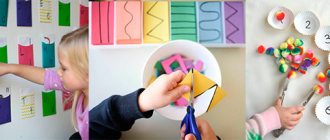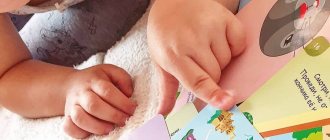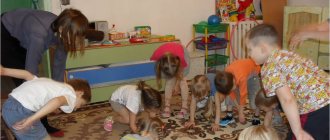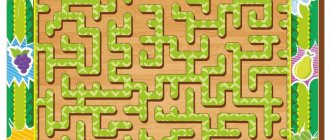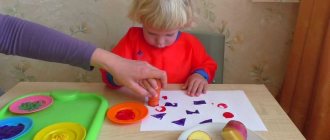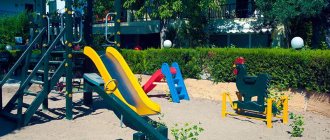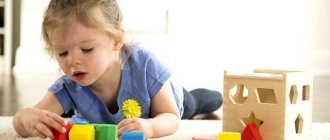Classes for children 4 years old should be developmental and prepare the child for entering school, teach the child to read and write, develop his abilities, and knowledge of the world around him. Experts say that at 4 years old it is already possible to sit a child at the table and study according to manuals for preschoolers. But in practice, a child will not sit for more than 15-20 minutes at a developmental notebook or book - this is the time that each task from such manuals is designed for. There are, of course, children who can sit with developmental notebooks and study with enthusiasm for 30 minutes. But when a child doesn’t want to, there is no need to force him. A 4-year-old child is very active, he is interested in running, jumping, playing with toys, and your task is to develop him through play.
How to teach a child through the game in which he spends most of his time? Let's look at: how to turn games into educational activities for 4-year-old children, what toys and materials will help you with this; What educational notebooks and books do children enjoy studying with?
What and how to develop in classes with children aged 4 years
- Fine motor skills, sensory skills. Model from plasticine, clay; assemble the constructor; make crafts from natural materials and cereals; weave from ropes and elastic bands; plant beads; draw with sand, sculpt from it; paint and draw with pencils and brushes, using different hands and holding the tool in different ways, making different strokes.
- Logic, thinking. Play board games for children (lotto, dominoes, go through mazes); solve riddles; play “What happens if...? (the ball will fall into the water, it will rain, etc.)"
- Attention, memory. Ask questions, for example, about what the child saw on the street when he was walking - “What color was that dog, who did you meet on the playground, what was he wearing, what color, etc.”; ask to talk about a story from a book you just read; collect construction blocks from memory, draw from memory; play reverse cards with pictures that the child must remember, etc.
- Grammar. Learn letters and names of objects starting with that letter in a playful way. When learning letters, you can simultaneously begin to study simple syllables.
- Arithmetic. Learn numbers and counting, addition and subtraction of simple numbers in a playful way.
- Speech development. Learn rhymes. During the game, ask the child to tell, offering him different items and objects: “What kind of object does he see in front of him? What is he doing? What is it for?
- Fantasy and creative skills. Draw; sculpt; assemble the constructor; do crafts; be sure to learn songs and sing with the children; dance to music, learn joint dances; come up with puppet shows, improvise with the plot.
- Physical skills. Dance, with ribbon, sword; play Twister and other outdoor games; do children's yoga; walk on bicycles and scooters, play outdoor games.
- Knowledge of the surrounding world. Study the time on the clock; seasons and months; weather features; animals and where they live; urban and natural sites; forms; textures; smells; colors, etc.
What should a 4 year old child know?
If your child doesn’t know yet, start learning:
- Times and months of the year.
- Time of day on the clock.
- Days of the week.
- Directions (left, right, up, down, etc.).
- Alphabet and first short words.
- Digits and counting prime numbers.
- Adding and subtracting prime numbers.
- Colors.
- Forms.
- Types of animals.
- Transport.
- Plants and natural objects.
- City objects.
- State of nature and weather.
- Properties of objects and objects and their application (this is how you will develop the child’s vocabulary and speech as a whole).
- City sounds, sounds of nature, animals, etc.
- Smells.
Required additional activities for children aged 4 years
- Singing.
- Studying the rhyme.
- Solving riddles.
- Reading with mom.
- Dancing.
- Physical exercises (on a fitball, with a tape, a bicycle, a scooter, a ball and other games that develop the child’s physics).
- Applied arts (drawing with brushes and pencils using different hands and holding the instrument in different ways, modeling, applique, weaving)
We have already written articles on how to teach a preschooler some of the above skills - read in more detail by following the links with the skills you need.
Activities for children aged 4 years using benefits
It is better to buy all manuals, books and notebooks in bookstores, rather than download them from the Internet and print them on a home printer. You won’t find material of decent quality on the Internet, and when printed on a home printer, it will deteriorate even more - you can’t offer this to children, you risk ruining all the fun of the lesson. But even in a bookstore, you need to choose with special care, so that the book is compiled by progressive specialists, the tasks are clear and interesting to the child, and the pictures awaken additional interest in the lessons.
- The manual “Annual course of developmental activities (for gifted children 4-5 years old)” includes a full annual course of developmental activities for children 4-5 years old in the main areas of preschool education: literacy, mathematics, preparing the hand for writing, getting to know the outside world, development of speech, logic, attention, imagination.
- Set of 7 manuals “School of Little Geniuses. For 4-5 years old" is a comprehensive program of classes that covers all areas of child development and education and complies with the Federal State Standard for Preschool Education. Each kit contains methodological material to prepare a child for school and general development. Each book contains entertaining educational tasks, exercises and games.
- Manual “Annual course of studies. For children 4-5 years old" contains the main topics of preschool education, with pictures of the child's favorite multiplex characters.
Recommendations for choosing a benefit
What to look for when choosing developmental aids, books, workbooks with tasks for children 4 years old:
- Almost all manuals with tasks are designed for a certain age and it is indicated on the cover - select by age.
- Activities for children for 4 years old must correspond not only to their age, but also to their abilities - the child must solve all the tasks assigned to him without making excessive efforts, otherwise he will need to move on to easier tasks, and there is nothing wrong with that. This way you will maintain your child’s interest in classes without discouraging the desire to learn.
- Choose professional authors who compile manuals; usually their experience and qualifications are described in the manual itself - the author must have a specialty and considerable experience in teaching preschoolers.
- Choose manuals with high-quality illustrations - this is very important for children. Illustrations should be: colored in calm colors, consistent with the original objects, without excessive brightness; aesthetic, kind and sweet; understandable for a 4-year-old child, with the basic features of identifying objects (the hare should look like a hare); depict adequate emotions, gestures and movements; images must correspond to the text and be consistent; There should be air around the images (white background) for better perception.
All these recommendations are met by manuals from KUMON (the world's largest children's additional education center), which contain high-quality illustrations and assignments compiled by highly qualified specialists.
- Manual “Logic and Thinking”
- The manual “Getting ready for school. Learning numbers and shapes. For children 4-5 years old"
- The manual “Magic labyrinths. For children 4-6 years old"
- “Learning to tell time. An hour and half an hour. For children 3-5 years old"
- And other benefits from the KUMON training center"
How to study with benefits
Classes on manuals, at the initial stage, should take 15–20 minutes. A four-year-old child is not able to sit for more than this time, and you should not force him. Choose those tasks from the manual that the child is more likely to be interested in, unless a clear sequence of tasks is recommended. Don’t forget that it is important to do everything with pleasure, praise your child for completing a task correctly, and not scold him if something doesn’t work out. Remember that these rules are important, especially if you want your child to study well and with interest in the future.
The manuals contain activities for children aged 4 years:
- on the development of logic and thinking;
- attention and memory training;
- imagination and creative skills;
- training fine motor skills of the hands;
- literacy tasks;
- arithmetic tasks;
- tasks for speech development;
- introducing the child to ideas about the world around him.
There are manuals for each of the areas separately, and there are those that contain all the necessary categories, which is quite convenient.
What did I do for the child?
I took a course on the development of children 3–6 years old just in time - now Sophia is at the age when she can have time to apply all the new knowledge in her upbringing. This is important for me as a mother of two children: when my son grows up, the environment for him will be ready. Because now I know exactly what my children need and how to give it to them.
Arranged areas for development
I recognized my daughter's needs and learned to create conditions in which she would enjoy exploring the world around her.
Russian language and reading. I made a tongue zone that would be interesting for the child. Sophia is in the midst of the period when acquaintance with letters occurs most quickly and easily.
I purchased two movable alphabets and a basket with items for sound games. We also have a lot of books and cards to expand your vocabulary.
English language. I really want bilinguals, so I have two options: send my kids to a bilingual kindergarten or teach them myself. I chose the second one.
I rewrote the names of all the songs and poems recommended for children, found old printouts with exercises using the Montessori method from an American website, remembered YouTube, where there are many English-language presentations, and decided that I would gradually start talking to my children. There are basic skills for this.
Sensory development. For anyone who is thinking about how to develop a child at 4.5 years old, arranging an environment for sensory development is one of the main steps. I learned how to do it correctly, and most importantly, I didn’t have to buy anything. It’s easy to do a lot of things with your own hands from things that are in every apartment.
Now my daughter has a lot of activities that help her get acquainted with objects, their shape and properties. I especially liked the idea with the stereognostic bag.
Environment and culture. On the Internet I found a huge number of ideas for studying the world around us with children using Montessori. But this was the difficulty: there was a lot of information, but it was not clear where to start. During the course I learned what, in what sequence and why everything needs to be done.
We have a relief physical globe and a world map in the form of hemispheres. I would like to pay more attention to studying geography, but for now I am sticking to the ready-made plan from the course experts. Then I will improvise if there is a desire.
Mathematics. So far, my daughter hasn’t shown much interest in numbers and counting, but I’m sure she’ll like math baskets and games with cubes. They are already ready, I will offer them as soon as I notice a need.
Creation. We don’t yet have a strictly defined place for creativity. After completing the course, I will be able to assess the scale of the required space and adjust it, taking into account the needs of both children. Now there is an easel and everything necessary for creativity, the child comes up with a lot of things - I just have time to collect and give out materials.
Music. I am far from the world of music. Studying the Montessori method helped to understand how important it is to develop attention to sounds in a child, how it affects rhythmic perception and helps to form melodic and harmonic hearing.
I plan:
- buy colored bells;
- dance to your favorite tracks (now I know how and which ones to emphasize);
- do not use music as background.
Storage of educational toys. We already have three shelves of three or four shelves (for two children), two tables, and an easel.
Set up practical life exercise areas
UPZh are needed not only for the development of everyday skills, but also for the sake of practicing movements. Before I became acquainted with the Montessori method, it was not obvious to me how many different movements a child makes with his arms and legs when performing such exercises.
Personal care. Previously, when thinking about how to develop a 4.5-year-old child at home, for some reason I did not attach importance to the aesthetic component. But the appearance of everything that surrounds a child at home is important.
I am planning in the near future:
- find a beautiful, suitable-sized basket for children for two corners of the bathroom, purchase good products, washcloths that will bring a rich sensory experience and pleasant sensations;
- resolve the issue with toothbrushes and toothpaste;
- pick up the light;
- place a box with disposable soft wipes;
- find a box for jewelry and hairpins;
- bring a headband holder;
- buy additional beautiful combs.
Sophia brushes her teeth and takes a shower on her own.
Now the place with the mirror looks like this.
My daughter enjoys using her jewelry box
Before taking the course, I thought that my child knew how to dress himself. This is true, but much remained unnoticed:
- When clothes are too small or uncomfortable, tantrums happen. I didn’t think that this could or should be corrected somehow. It felt like I got used to hysterics and stopped noticing them. As a result, she revised her eldest daughter’s wardrobe and began to behave with restraint. Now, when a child can’t put something on or take it off, she calmly asks for help. This is our small victory.
- Sophia did not fold her clothes, leaving them lying around inside out. I understood why it shouldn’t be this way, and what the consequences of not completing actions are in the future.
- We didn't sort out our daughter's things. Now I know how important order is: a child is interested in arranging things. In addition, it develops motor skills and coordination.
My daughter has her own drawer for every item.
Development in the kitchen. We removed the doors to open up the kitchen. We are planning to purchase a silicone mat, replace some cutlery, stock up on replacement towels, mittens, and tableware.
We made a separate tap for drinking water - it can be poured into a jug or cup. Wash dishes and hands at a regular sink
Now we set the table before all meals: like for a holiday. And I'm much less tired
Environmental care. I have a big plan for environmental care areas, and it inspires change. There is an understanding of how to introduce a child to everyday life and why it is important to show that he can do everything himself. This is important for the development of a child at 4.5 years old.
This is what the environmental care kit looks like now
We placed the flower in the kitchen, we will soon bring a basket of care products here
Educational activities for children 4 years old in a playful way
The child is constantly in the game; parents only need to include the educational aspect in the game. Almost all games can be turned into educational activities for children 4 years old and older. And almost all toys can become educational material.
Constructors
Construction sets come first among educational toys. The construction set is a toy without gender division, as was previously thought; it will be equally interesting to both boys and girls. It is advisable to choose sets not only with different blocks, but also with characters, auxiliary items and objects. There are construction kits with the alphabet printed for learning letters; there are numbers and addition and subtraction signs; also constructors that introduce children to the world around them, animals of different countries and continents, seasons, professions. For example, “Lego Duplo” - in this series the parts are quite large, there are sets for the little ones from 1 year old, and there are from 2-5 years old. The following series of the designer come from 3 years of Lego Classic - it has smaller parts and there are more of them in the sets. You can choose separate series for boys and girls.
Games with a constructor, we develop:
Fantasy and speech skills
Ask your child questions while playing, let him imagine what will happen next. Let's give the task to come up with a new figure from the designer, it is not necessary to assemble only according to the diagrams. Act out scenes with the characters of the designer, come up with names for them, activities, where they will live, who they will be friends with.
Logic
Just build from blocks, with or without diagrams, create your own schemes. Draw a shape, the boundaries of an object or a letter on a piece of paper with a marker, and let the child put it together from blocks. Set boundaries for colors and shapes. The cubes can be used in many ways, even making patterns on the floor. You can write numbers and letters on the cubes and stick small stickers on them; then give the child tasks: to put together such cubes with images according to some characteristics or meaning. Build a labyrinth out of cubes, ask the child to go through it on his own, ask him to build a labyrinth for you.
fine motor skills
The smaller the parts, the more quickly the child learns to handle them, developing his fine motor skills.
Attention and memory
By assembling the construction set according to the diagram attached to it, the child learns to follow it carefully. There are a lot of separate books with new patterns for the Lego constructor, which can be purchased additionally in bookstores. You can draw up your own diagrams, sketch them, make your own catalogue—isn’t that an interesting project? You can also use these skills during the game itself, for example, by giving the task to collect from memory, as before, all the cars of a collided and crumbled train, etc.
Grammar
You can use a marker to write the letters of the Russian alphabet on the cubes, or stick stickers with letters and other images on the cubes, which you can also do with your child. These little stickers are sold in bookstores for planners. With the help of such prepared blocks, you can teach a child: asking you to select a letter to the desired image, putting the letters into syllables by connecting the blocks. You can make printed letters from the blocks themselves, after first drawing a diagram on a piece of paper. You can use blocks with letters and other images along with educational notebooks and books to make your learning more interactive and interesting.
Counting, addition and subtraction
Use number blocks and addition and subtraction signs that you can prepare with your children as described above. Or, for example, play a construction game: ask for a certain number of blocks of a certain color to be delivered to you, then add a few more of a different color, and stuff like that. The child perfects his counting in such interesting games.
Speech development
Use cubes with stickers depicting various objects - this way you can play store with characters, asking the child, in the role of a consultant, what he will recommend and why. Help him by introducing new words and let him use them in his explanations. Provoke your child to comment on the actions in the game - ask guiding questions. Learn to structure sentences correctly: by playing, for example, on a tourist excursion or in a train station, announcing the necessary announcements for train passengers.
Pros and cons of the designer
Pros of the construction set: If you use your imagination, the construction set is a very multifunctional toy, with it you can come up with a lot of educational activities for children of 4 years and almost any preschool age, and besides, it is so interesting.
Disadvantages of the designer: Many parents complain about small parts scattered throughout the house. However, this can be dealt with: build a special play mat for the construction set; which is pulled into a bag, collecting all the parts, at the end of the game.
Parents also note that their child assembles construction sets only according to diagrams without showing imagination. There is a solution here too - buy classic Lego Classic blocks, they are designed so that the child will come up with figures and games on his own.
Board games
Board games are very popular today. This is not only educational activities for children aged 4 years, but also a fun time with parents and friends, the joy of winning, and training in an adequate attitude in case of loss. Board games are designed for different ages of children; for preschoolers these can be: puzzles for learning the alphabet; dominoes with images, numbers and letters; various walkthroughs with simple rules; or card games with beautiful illustrations. All this can be found in toy stores.
- Good educational games for preschool children are published by the publishing house LISCIANI; you can choose individual games for the development of any skill or sets.
- Another good manufacturer of educational games is Miniland. The games are intended for the development and education of preschool children.
- And of course, the quite popular “Tenth Kingdom” produces a very large assortment of educational and educational games for children, with their favorite cartoon characters, for children of different ages.
- When looking for a game to develop a specific skill (learning letters, writing, reading, counting), consider all publishers of educational children's games. The choice is large, but you can find almost everything you need for educational activities with children.
The advantages of children's board games: Such games are built according to a ready-made plot (rules invented by the developers), you do not need to come up with tasks yourself, as with a construction set.
Disadvantages of board games: They have limited functionality and are almost always limited by instructions.
Favorite toys
Any children's toys can become educational activities for children aged 4 years, here it is the same as with a construction set - the main thing is to show your imagination.
Some ideas for playful activities for boys
If your child loves cars, you can stick letters or numbers on them and make a parking lot for them. For each parking space, stick or draw an image whose name begins with the letter pasted on the car. Or paste the number of images that are written in numbers on the typewriter. Stick addition, subtraction, and even signs on the cars - and you can solve examples while driving around the playing field (track).
On whatman paper you can draw a route with cities, forests, natural and architectural places, you can even depict weather conditions. When driving along such a highway, study the directions with your child (left, right, up, down); develop your speech by asking questions - “What happens if you turn left, where will you arrive? What can you do there?"; draw route maps so that the child follows them to reach the desired destination, this way he will train attentiveness.
Show your imagination and come up with your own games and tasks, in them you can develop and learn everything that teachers teach children 4 years old in preschool institutions.
Several ideas for playful activities for girls
Almost all girls love either dolls or toy animals - and there is a huge scope for imagination. You can also learn the alphabet with dolls and animals by sticking letters on them; Give candy to the dolls, let the dolls share with each other, count how many candies the dolls have under different conditions, etc.
Dolls and animals are great tools for role-playing games. We play shop (we study addition and subtraction, letters, how to write the names of products, develop speech and thinking). We play theater (we develop imagination, speech, logic, memory, thinking) - we come up with short scenes, characters, names, memorize short poems; you can take a fairy tale from a children's book and stage a puppet show with toys based on the book.
Even a simple role-playing game of improvisation will help develop all the necessary skills - ask the child as many questions as possible about the environment, talk about what he does not yet know.
Advantages of educational activities with favorite toys: The child is already immersed in games with his favorite toys, offer new scenarios in his game - interest in the activities is guaranteed.
Cons: You will have to actively use your imagination when developing a scenario for developmental activities, prepare additional materials (printouts of letters, numbers, cards with additional items). Although all these additional materials can be bought at a children's or bookstore.
Available materials
Perhaps the most creative educational activities for children aged 4 years are crafts from scrap materials. A variety of projects can be created from: natural materials, cereals, empty packaging, household items, paper and special materials for creativity.
Start with what you want to do (what task is ahead of you: learn letters, develop fine motor skills, etc.), what specific available tools are suitable for this, how to reliably glue or connect them - you need to show so much ingenuity. If you want to grow a creative personality, then more often resort to games made from improvised and natural materials.
Cereals and other small bulk objects (we develop motor skills and sensory skills)
Cereals can be sewn into toys made of thin fabric.
You can place the flour in an inflatable ball, deflate the air and tie it in a knot - the ball will hold its shape well. You can additionally decorate it with plastic eyes and attach hair (a thread tassel).
You can draw with grains and sand by placing them on a tray or gluing them to a sheet of paper.
By pouring cereal or sand into a box, you can make a playing field (beach, construction site, garden) for a child to play.
Paper
Children's origami, the simplest, can be done by a child as young as 4 years old.
Applique: You can help your child by drawing simple shapes, let him cut them out with children's scissors and glue them himself.
You can cut out any objects for learning from paper, make educational notebooks with elements of appliqué and drawing (a doll's house, a track for cars with different locations, a forest, a city, a store, etc.) Use ready-made stickers in such notebooks, children love them very much .
Tubes, toothpicks
Cut tubes or use matches to fold an applique or build a house, use glue.
You can make a chain from the short parts of the tubes, connecting one end to the other.
You can make a hedgehog or a porcupine from a toothpick and potatoes.
You can build a helicopter from tubes, thick paper and a toilet paper roll, then paint it with acrylic paints.
Natural materials (cones, twigs, pebbles, acorns...)
From all this goodness you can get a lot of crafts of animals, birds, and people. Use plastic eyes, bright threads and colored paper.
Large smooth stones can be painted and turned into fancy creatures by attaching eyes and rope tails to them.
Threads and balls
Remember, you probably made dolls and animals from pompoms out of strings.
Threads can be woven and tied to mesh fabric to create intricate patterns.
And these are just a few of the ideas that can be developed using available materials. Lesson principle: lay out the necessary materials in front of the child, give a direction, offer to make a craft using a little ingenuity. Guide your child, offer your ideas if he is at a dead end. A child, coming up with and bringing such ideas to life, develops not only creative skills, he learns logic and non-standard thinking. And be sure to accompany your classes with guiding questions, counting, writing letters or numbers, come up with names, stories, study everything that comes to your hand.
Daily routine
And don’t forget that your educational play can be used to benefit the household and develop independence in the child. What kind of household chores can a child be entrusted with?
Cleaning. Think in advance about each place (house) for toys, where they will live when they are not playing with them. By the end of the game you will need to send the toy to rest (go home to sleep). And be sure to follow with leading questions - “What will your black fluffy bear cub do at home before going to bed? Place a (toy) piece of fruit next to him for him to eat before bed. What fruit will you put in? What colour is he? Maybe put another one, how much fruit will the bear have then?” etc. Each item can be assigned a place (house) to which it must return to rest, otherwise it will become wrinkled, dirty (dusty), or lost.
Loading the washing machine and dishwasher. This is also a kind of quest for a child - to sort all things by color, texture, shape and purpose, set a program, there are numbers and letters that need to be remembered until next time. Children really like to press buttons, let them do it under supervision, - “I’ll check for you so that you don’t forget anything, otherwise you can break it...” - and then explain that - “When the program is running, you can no longer break it by pressing buttons, like and you can’t press it just like that, because it might break and flood your neighbors and us...” Be sure to accompany all actions with detailed explanations. Trust to load the dishes in a certain order, put one piece of dishes next to another of the same kind, set the program, etc.
Cooking. It’s a creative process, but you need to stick to the recipe, study new ingredients, their smells and tastes, and keep count. Trust your child to add to a recipe, explore and learn about ingredients, mix, layer, decorate, keep track of time—anything he can help with in cooking that will broaden his horizons and be appropriate for his age.
Dating games For kids 5-8 years old
Let's get acquainted
Children stand in a circle. The presenter begins the game with the words: “Hurry up. What’s your name, tell me…”, while throwing the ball to one of the players. He catches the ball, says his name, then he throws the ball to another player, while the words are spoken again: “What is your name, tell me...”, etc.
Round dance dating
All the children, holding hands, lead a round dance with the words: “We walk and walk in circles, We want to get to know each other, Only those whose names are standing are standing... (Seryozha), Well, you and I are sitting.” After these words, the children whose name was called remain standing, while the rest crouch. Then the game continues.
Sparrow
All children stand in a circle. The leader stands inside the circle. The children jump on one leg in a circle in one direction, and the leader inside the circle in the other direction, and at the same time says: “The sparrow jumps, jumps, beat, beat, gathers all the friends, zey, zey, many, many different us-us- us, They will come out...(Lenochka) now, one o’clock, one o’clock.” The named children enter the circle, take the leader’s hand and the game is repeated until the names of all the children are named.
Ball
The presenter holds the ball in his hands and says: “A multi-colored ball jumps along the path along the path along the path From the birch tree to the aspen tree From the aspen tree, turn, Straight to ... (Ira) to the garden!” With the last words, the counselor throws the ball up. The children whose name was called must catch the ball. The one who caught the ball makes the next throw. If a name is named but there is no child with him, then the ball is caught by the presenter and he makes the next throw.
Fun tasks
“Listen, laugh, do it, remember names,” with these words the presenter gives the task to the children.
Sasha took Marin by the hands and danced. The Lenas sang the song “A Christmas tree was born in the forest.” The Leshas took Tanya by the left hand and jumped. The lights race towards the body, etc.
Green oak near Lukomorye
Equipment: tree with leaves attached: children's names are written on the leaves. Progress of the game: 1st part. The leader tears off the sheet, reads the name written on it, and calls the child with that name. The called child comes out and picks the next leaf from the tree, etc. 2nd part of the game. The presenter distributes leaves with the children's names in disarray. Task: exchange a piece of paper with your name from the players, run up to the tree, attach the sheet, saying your name. The one who is faster than others wins.
It's me!
The players stand in a circle. The presenter, standing in the center, calls two names (one female, the other male). The players whose names have been called shout: “It’s me” and change places. The presenter's task is to take the vacant seat. The one who did not have time to take an empty seat becomes the leader. If of the two named names there is only one person with that name, he shouts “It’s me” and remains in place.
Teremok
The first player approaches the presenter and asks: “Who lives in the little house? Who lives in a low place? I... (Irochka) Who are you? I... (Sasha).” The second player approaches them and the dialogue is repeated.
Hello
The players stand in a circle, shoulder to shoulder. The driver walks along the outside of the circle and touches one of the players. The driver and the player who was hit run in different directions along the outside of the circle. Having met, they shake hands and say “Hello!” and they call their names. Then they run further, trying to take an empty place in the circle. The one who is left without a place becomes the driver.
Call yourself, call me
Players are divided into 2 teams, which are located opposite each other at a short distance. One of the teams receives the ball. At the leader’s signal, the first player of the team throws the ball to the player of the 2nd team, calling his name. He catches the ball and returns it to the next player of the 1st team, calling his name. The player standing last, having received the ball, passes the ball in the opposite direction, but already says his name and the name of the person to whom he throws the ball. And so on until the ball falls into the hands of the 1st player of the 1st team.
Dating phone number
The players stand in a circle. The presenter whispers any name to the player standing on the left. Everyone will recognize this name along the chain. After this, the presenter says: “1,2,3, run in a circle!” The players whose name was called must run into the circle; their neighbors try to hold them back. Those who were able to run to the center of the circle tell a little about themselves, and those who couldn’t, complete tasks given to them by other players. The game is repeated, but with new names.
Our friendly family
Players are divided into 2 teams. Each player gets a pin. Teams line up in 2 columns. At the driver’s signal, the first players run to the first marks and place pins, shouting out their names. After this they return to their teams. The 2nd player of each team, running past the 1st pin, calls the name of the 1st player, runs to the 2nd mark, puts the pin, shouts out his name and comes back, etc.
Girls-boys
Boys sit on one bench, and girls on another. Boys call any girls' names. If these names are girls, then they stand up and tell a little about themselves. Then the girls call any names of the boys. This continues until the names of all the children have been named.
Chairs
We place the chairs in a circle close to each other. The players stand on them. At the leader’s signal, all players must change places so that all names are arranged in alphabetical order. Players move on chairs without touching the floor.
Romp
At the leader’s signal, all players begin, shouting their names, to look for their namesakes in order to assemble into a team faster than others. The noisiest and fastest win.
Cheat sheet
Each player receives a card with his name. Players are divided into 2 or 3 teams. The 1st group enters the game. All players in this group introduce themselves, giving their first and last names, and tell a little about themselves. After this, all cards with the names of the players of the 1st team are given to the opposing players. After consulting, they must correctly distribute the cards to the players of the 1st team and remember everyone’s last name. For each correct answer, the team receives a point. Then the 2nd team introduces itself.
Who is who
Each player receives a piece of paper and a pencil. 5 minutes after the presenter’s signal, the players must get to know each other, finding out the name and who they want to become. The received data is recorded. The one who manages to learn and write down the most wins.
Gender of the word
The participants of the game sit in a circle and throw the ball to each other. At the same time, the thrower loudly says the first syllable of his name; the one who caught the ball must quickly pronounce the second syllable. If the name is correct, then the thrower says the name in full. If the name is called incorrectly, then he says “No”; and waits for someone to say his name correctly, etc.
Relay race
Before the competition, players are divided into 2 teams. Each player takes a step forward and clearly pronounces his first and last name. Stage 1: team players take turns running up to their piece of whatman paper and writing their last name, returning back and shouting their name. Do this until all players have signed up. Stage 2: teams must exchange sheets of whatman paper. Running up to a piece of whatman paper, you need to write his name next to the corresponding surname of the enemy. The team that made the fewest mistakes wins.
Helpline
Boys sit opposite girls in pairs. The girls whisper their name to the boy from their pair. After this, the boy sitting in the 1st row tells his neighbor the name of his partner. He speaks quietly so that the other boys don't hear. The 2nd boy tells the 3rd boy the name of the 1st girl and the one sitting opposite him. So until they reach the last boy: he calls the names of all the girls in turn. If the name is named correctly, then the girl stands up; if not, she remains sitting. Then the girls find out the boys' names, etc. The team that was more accurate wins.
Let's open our hearts to each other
Each player receives a heart-shaped token on which he writes his name. The presenter walks in a circle with his hat. Players say their names out loud and put a heart in their hat. The players' task is to pull a heart out of the hat, read the name and give it to the owner.
Battery
Children stand in a line, holding hands. A leading plumber is selected. He stands with his back to the players and says: “The water has started to flow.” After this, the children take turns saying their names. When they reach the last one, players continue calling names in the opposite direction (2-3 times). After this, the presenter says “The tap is turned off,” turns to face the players and calls their names. Each correct answer is a point. After this, a new leader is chosen, and the game resumes.
What do your names mean?
Children are divided into teams with the same names (Sasha with Sasha, Lena with Lena, etc.). assignments: Presentation: “Your name is your talisman.” A song in which your name sounds (who is better). Ekibana of flowers and plants starting with the same letter as your name. The emblem of your name (who is more original).
Postman
Children are divided into 2 teams. The first players each run up to their chair, on which there are small envelopes (according to the number of participants). On the back is the name of the recipient from another team. Having read the addressee’s name, the “postman” shouts it out loud, and the addressee raises his hand and shouts: “It’s ME!” Then he goes for the next letter. The fastest team wins. Organizers can write the meanings of the names on the back of the cards. These cards can be announced and given away at the end of the game.
Mathematics
Children sit in a circle. The counselor gives the task: “Let’s start counting in a circle. The one who has a number that is a multiple of three pronounces his name instead of the number.” This game can be used to develop memory and attention. Play and you will see that this is indeed the case.
Give your name
Everyone stands in a circle, holding their arms outstretched in front of them. The player who starts the game throws the ball through the center of the circle to one of the participants and says his name. After the throw, he lowers his hands. After the ball has passed everyone and everyone has dropped their hands, the game begins in the second round. Each participant throws the ball to the person he threw to the first time and says his name again. The third round of this game is slightly modified. Again, everyone stands in a circle with their arms outstretched, but now the participant who threw the ball must say his name, the one who caught the ball does the same, etc. After playing this game (it takes 10-15 minutes to play it), it’s quite possible to remember up to 20 names.
Who? Where? When?
The players stand in a circle. At the driver’s signal, the children are rearranged so that the names are arranged: In alphabetical order; By month of birth; According to zodiac signs; Hobbies, etc.
Guess my name
Instead of introducing the player gives clues:
My name starts with the letter "O"; My name ends with the letter "A"; It consists of 6 letters (Oksana). The one who guessed the name correctly gets a token.
Declaration of love
A boy and a girl are called. They tell each other their names. They need to play a scene from a movie about love. All feelings can be expressed only by facial expressions and gestures, only names can be pronounced. The couple that is the most original and artistic wins.
Zodiac signs
Players are grouped by zodiac sign. They prepare messages about themselves for other players about the characteristics of their characters. You can use popular literature. The main thing is that all performances are original and all team members take part in each.
Interview
Each player receives a card with the name of each participant written on it. At the presenter’s signal, you need to find a partner whose name is written on the card and interview him. The list of questions is determined by the game organizers. All information must be written on a piece of paper. All notes are placed in the newspaper “Let's get to know each other!” Those who complete the task before other players win.
Vanity
Each participant in the game receives a list of 10 items:
loves to fish... loves to sing... loves to read... etc. The lists of players are different. The organizers will find out the contents of their lists of favorite things to do in advance from the players personally or from questionnaires. At the driver’s signal, the players begin to fill out the lists, writing the corresponding names of the players next to their favorite things to do. To do this, everyone begins to learn from each other who likes to do what. The winners are those who can complete the entire list first.
My emblem, my motto
Each player receives paper and pencil. At the presenter’s signal, everyone comes up with and draws something that can be an emblem and writes a phrase or word that can serve as his motto (this could be a proverb, a phrase from a song, a catchphrase, a movie title, etc.). then we do an exhibition of works, where everyone talks about themselves, about their work.
My partner
Children are divided into pairs. They are given 3 minutes, during which they must learn as much as possible about each other. Then everyone sits in a circle and each player talks about his partner. Presentation style - any. Originality is encouraged.
Fanta
Each player is asked to choose 1 of the cards. Each contains 2 tasks:
About hobbies, friends, pranks. Name, age, school, class. Sing a song (tell a joke, read a poem, etc.)
Street dating
All participants in the game are divided into pairs. The task of one of the participants in the couple: to meet the second person, a complete stranger to him, right on the street. To do this, he uses maximum effort and all his resourcefulness. You need to find out the name and favorite activity. The 2nd player tries to get away from the acquaintance without saying a single rude word. At the end of the game, all participants determine the most successful “seducer” and the most intractable “stranger.”
Guess yourself
The participants of the game sit in a circle. The presenter reports that a sudden accident has frozen the lips of all the players. And they cannot directly introduce themselves and get to know others. It is only allowed to make hints that contain 2 association words or historical figures by which your name can be recognized. The root of my name is similar to the word for a woman's jewelry; I am the sister of Olga Larina (Tanya); I am the namesake of Mayakovsky (Vladimir); My name means a great feeling (Love), etc.
Central name
During a disco, the dancers form a circle. All Sasha and Lena are called to its center in turn, who dance in the center of the circle, and the rest call their names to the beat of the music. After some time, the central dancers change. This continues until all players are in the center of the circle.
Snowball
The players sit in a circle. The first says his name, the second says the name of the first and his own, the third says the names of the first and second, then says his own, etc., until the circle is closed. As a result, the last one in the circle says the names of all the players, and then his own. It’s easier, of course, to be first, but last is more useful.
I'll take it with me on a hike...
One-time game. Everyone must name his name and some object (my name is..., I will take with me..., will I go on a hike?) that he would take with him on a hike. The host must say whether he is taking this person with him or not. The idea is that the name of the item begins with the same letter as the child's name. Ask the guys who guess to remain silent until everyone understands the logic.
Let's get acquainted
The players form two circles. Those standing in the inner circle turn to face the outer one. Music sounds, players play in circles and move in opposite directions. After the music stops, the participants in the game stop in front of each other, introduce themselves, saying their names. Then the music sounds again, only now, moving in different directions and running past an acquaintance, they wave to him. The music stops playing, new acquaintances appear. Game continues.
Sing your name
Each player takes turns singing their name. Everyone else must repeat the name, that is, sing it in the same way, with the same intonations, etc.
Who's faster
The squad is divided into 2 teams. Between teams, assistants hold a screen (for example, a blanket). One person per team approaches the screen and crouches; they should not see each other. At the command of the leader, the screen is lowered and the players sitting near it must say each other’s names. The one who calls faster wins. The loser moves to the opposing team. Etc.
I never…
Everyone sits in a circle and puts their hands on their knees. The first player says something he has never done in his life. For example, he says: “I have never flown on an airplane.” If one of the players was flying, then he bends one finger on his hand. Then the next player speaks, and so on in a circle. The winner is the one who bends all his fingers the fastest.
Tutti Frutti
Everyone sits in a circle on chairs and settles for first or third. The first numbers will be, for example, apples, the second – bananas, the third – oranges. In the center is the driver, who begins a story about himself and as soon as he mentions one of the named fruits in his story, these players must quickly change places. If the driver says: “Tutti-frutti,” then all the players change places.
Bullseye
The players sit in a circle. The counselor says: “My name is..., I love...” (you can love anything and anyone) and rolls the apple to someone from the circle. He picks up the apple and also says: “My name is..., I love...”. And the apple rolls to the next one. The game continues until all players have introduced themselves.
Bingo
Participants form two circles - one inside the other, with an equal number of people. The circles rotate in different directions, facing each other, to the words: “My shaggy gray dog sits by the window. My shaggy gray dog is looking at me. B-I-N-G-O (2 times) Yes, his name is Bingo.” The words “B-I-N-G-O” are pronounced separately by letter, and for each letter those standing in the outer circle clap the hands of those standing in the inner circle. For each letter - the palms of a new person. The last letter “O” is said drawlingly (surprisedly - joyfully) and the last words (“Yes, call him Bingo”) are pronounced by the couple together, holding hands. After which the participants introduce themselves to each other by name. This continues until everyone gets to know each other.
And I'm going, and so am I, and I'm a hare
The participants of the game sit on chairs in a circle, one seat is not occupied by anyone. In the center is the driver. During the game, all participants change seats in a circle counterclockwise. A player sitting near an empty chair changes to it with the words “I’m going.” The next player says “me too.” The third participant says “I’m a hare” and, hitting an empty chair with his left hand, calls the name of the person sitting in the circle. The one whose name was spoken must run to an empty chair as quickly as possible. The driver’s task is to have time to take the chair faster than the one named. Those who did not have time become the driver. The game starts over.
I'm a snake, snake, snake
Participants stand in a circle, one after another - a boy, a girl. The counselor begins by approaching someone with the words: “I am a snake, snake, snake, do you want to be my tail?” If the answer is yes, then the person being asked crawls under the leader’s feet, introduces himself, and with his right hand takes the person being asked’s left hand through his legs. If the answer is negative, the phrase sounds: “But you have to!”, and the clutch begins. Thus, each time the snake grows larger and larger. The game continues until all participants join each other.
Get text
